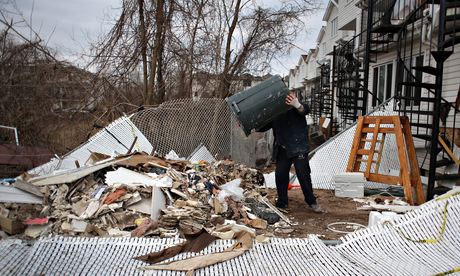Lloyd's calls on insurers to take into account climate-change risk

A home damaged by Superstorm Sandy in 2013 in the Staten Island borough of New York City. Photograph: John Moore/Getty Images
Lloyd's of London, the world's oldest and biggest insurance market, has for the first time called on insurers to incorporate climate change into their models.
The call to action comes a day after a landmark US report, named the National Climate Assessment, which has warned that climate change is wreaking havoc across the US.
Lloyd's says damage and weather-related losses around the world have increased from an annual average of $50bn in the 1980s to close to $200bn over the last 10 years.
The 326-year-old insurance market, whose members write insurance business worldwide, believes the time has come for a formal call on the industry to take into account various climate-change scenarios to avoid unpredictable losses to businesses.
What the industry describes as extreme weather events have increased in number and severity as the global climate system has altered, causing more and bigger hurricanes, typhoons and heatwaves around the world. In the UK the main climate-change related risk is flooding.
Typhoon Haiyan, which last November swept across south-east Asia, especially affecting the Philippines, was one of the strongest tropical cyclones ever recorded.
The year 2011 was the most expensive on record for natural disasters, with insured losses costing the industry more than $126bn.
Superstorm Sandy caused $35bn of insured losses two years ago, making it the second costliest hurricane in US history after hurricane Katrina in 2005.
A new report by Lloyd's, which consulted the world's largest catastrophe modelling firms, says a 20cm rise in the sea level at the southern tip of Manhattan Island increased Superstorm Sandy's surge losses by 30% (up to $8bn) in New York alone.
The 840-page National Climate Assessment, published this week, was described by John Holdren, the White House science adviser, as the "loudest and clearest alarm bell to date signalling the need to take urgent action to combat the threats to Americans from climate change".
Trevor Maynard, head of exposure management and reinsurance at Lloyd's, said: "Climate change is very much here to stay. Hurricanes are getting stronger worldwide, and especially over the north Atlantic … At the moment we are heading for a rise of four degrees [in temperatures] by the end of the century." He said that increased threats ranged from property damage to political risk – such as the implications for food security – and the economic impacts.
It could mean the insurance industry would need to hold more capital to protect against increased risk, he said.
Maynard said that while insurers typically arrange insurance cover for a stretch of one year, planners and building constructors would need to look ahead to the next 40 to 50 years.
Maynard said: "There is every indication that [storms] will get more extreme as the temperature rises." He noted that the report by Sir Nicholas Stern on the economics of climate change concluded that it was cheaper "to avoid it".
Lloyd's made a £516m loss in 2011 after paying out the largest catastrophe claims on record – caused by earthquakes in Japan and New Zealand, storms in the US, and floods in Thailand and Australia. The area flooded in Thailand was the size of Birmingham and it remained under water for a couple of months.
Since this year Lloyd's has been run by Inga Beale, who became chief executive of the company in January. The organisation, which started in a coffee house in 1688 where merchants insured ships and has evolved into a group of about 80 competing insurance syndicates, has insured a large range of items, from Keith Richards' fingers to satellites, as well as provided cover for homes and companies.